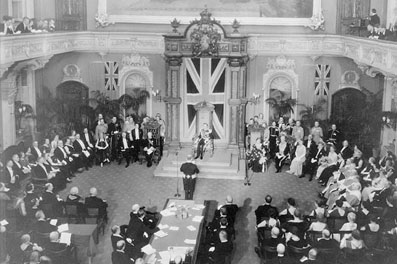The governor general
On this page
- History of the office of governor general
- The role and responsibilities of the governor general
- Installation of a governor general
- The governor general designate
- The administrator of the government
History of the office of governor general
The governor general represents His Majesty The King at the federal level in Canada.
The office of governor general is the oldest continuous institution in Canada and is an unbroken link with the early days of European settlement in our country. Appointed governor of New France in 1627, Samuel de Champlain was the first of 18 French governors who would hold the position in turn until 1760. From then until 1867, a total of 21 British governors and governors general held office in Canada. Until 1952, Governors General were British. The 1952 installation of Vincent Massey, the first Canadian to hold the office, reflected Canada's new sense of autonomy and identity in the post-war era and Canadian sense of pride in the Canadian Crown.
Vincent Massey's appointment was important, marking the beginning of the modern institution of the governor general where a Canadian represents The King and carries out His Majesty’s responsibilities in Canada. Since then, the role of the governor general has evolved. The following are among the responsibilities of Canada's governor general, all of which are undertaken in the name of The King:
- managing the Canadian honours system
- representing Canada abroad
- signing the letters of credence for outgoing Canadian diplomats
- signing treaties and declarations of war
- granting coats of arms to Canadians who petition to receive them
Appointed by The King on the advice of the prime minister, the governor general usually holds office for 5 years. Lieutenant Governors fulfill the responsibilities and functions of The King in the provinces in the same way that the governor general does at the national level.
The governor general bears the title “Excellency” during office, along with his or her spouse, and carries the title “Right Honourable” for life.
For more details, consult the governor general of Canada’s website.
The role and responsibilities of the governor general
In 1947, Letters Patent Constituting the Office of the governor general of Canada (under King George VI) authorized the governor general to exercise most of the Crown's powers on behalf of the Sovereign.
The governor general has important parliamentary responsibilities:
- summoning, proroguing and dissolving Parliament
- setting out the government’s program by reading the Speech from the Throne
- giving Royal Assent, which brings parliamentary bills into law
The governor general is also Commander-in-Chief of Canada. He or she visits military bases and honours Canadian military personnel on behalf of The King.
The governor general also fulfills important ceremonial duties:
- promoting a sense of identity
- recognizing the achievements of outstanding Canadians
- receiving foreign dignitaries
- travelling overseas as the representative of Canada
- hosting and taking part in official events
Installation of a governor general
The installation of a new governor general is intended to officially mark his or her assumption of office, replacing the outgoing governor general. It is an historic event which represents the most important state ceremony within Canada's constitutional and ceremonial structure.
Typically taking place in the Senate chamber of the Parliament of Canada in Ottawa, each installation ceremony is unique and reflects the preferences of the individuals involved and the ongoing evolution of the office of the governor general.
The main element of the installation ceremony is the moment when the new governor general takes the oath of allegiance. The chief justice or other senior judge of the Supreme Court of Canada administers this oath.
Another important element of the installation is the governor general's first address to the nation. This speech will set out the governor general's vision for his or her term of office in bringing to life the important and ongoing role of the Canadian Crown in the life of our country and its citizens.


Learn more about former governors general as well as the most recent installation ceremony of Canada’s 30th governor general, Her Excellency the Right Honourable Mary Simon.
The governor general designate
The governor general designate is the person who has been appointed as governor general, but who has not yet been sworn-in.
During the transition period, the governor general designate undertakes a series of briefings with various members of government, ensuring he or she will be able to step into the role of governor general without difficulty.
The administrator of the government
Under exceptional circumstances, it is possible for the governor general to be absent or for the position of governor general to be temporarily vacant. In such cases, the Letters Patent Constituting the Office of the governor general of Canada (1947) stipulate that the Chief justice of the Supreme Court of Canada will assume the duties of governor general on a temporary basis, as the administrator of the government, until an absent governor general returns to Canada and resumes their duties, or in the case of a transition, until the governor general designate has been appointed and sworn in as the new governor general of Canada.